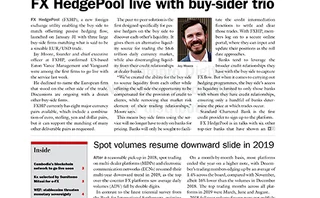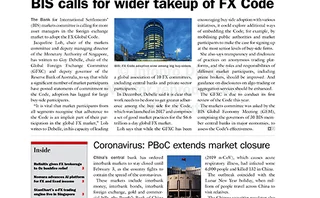
Offshore renminbi bond market to take off in 2012

One of the biggest success stories of the past year has been the explosive growth of the offshore renminbi (CNH) bond market, as investors piled in to gain exposure to a sharp appreciation of the Chinese yuan. The euphoria surrounding the notes - dubbed dim sum bonds - manifested in a surge of new issuance, with some CNH113 billion ($17.9 billion) in supply hitting the market in 2011, up from CNH36 billion the previous year. With funding rates as low as 1-2%, demand was easily matched by issuers ranging from the high-grade to the high-yielding names from both China and overseas. The market seemed unstoppable, at least, until it became clear that China was not immune to the global economic slowdown, and that the pace of yuan appreciation was about to slow.
Fortunes started to change almost overnight. Amid the escalating eurozone sovereign debt crisis, in mid-September economic data from China began to look more subdued, with export growth and PMI export orders slowing to levels not seen since the collapse of Lehman Brothers in 2008. Concerns that the effect of the weakening global economy would hit China's already shrinking current account surplus, which had dropped to 2.8% in the first half of 2011 from 5.2% in 2010, began to show in the unadulterated offshore markets. The CNH exchange rate spiked higher than the onshore Chinese yuan (CNY) rate, wiping off 3% against the US dollar, while CNH bond yields surged to 4.3%.
Since then, yields have come back to around 3.8% and, say analysts, better reflect the credit risk and liquidity risk premium of exposures being assumed by investors. Indeed, some argue that the performance of dim sum bonds last year was hardly remarkable for buyers.
A sense of disillusionment was perhaps also indicated by the declining rise in the offshore renminbi deposit base in Hong Kong in December and into January, as reported by the Hong Kong Monetary Authority (HKMA) (see figure 1).
But this, say analysts, is where progress is being overlooked, with many claiming the fall in the deposit base is a positive sign the market is opening up. Not only does it signal increased use of RMB in trade settlement, but also the extension of programmes such as the registered qualified institutional investor programme, which enables offshore RMB to move back for investment in the mainland.
Others point to the establishment of new renminbi centres such as Singapore and London as having also absorbed some of the deposits by creating funds run locally. And while the CNH might make its way back to Hong Kong, it will not be recognised as deposits held by residents. "The number the HKMA publishes is the amount of money held by residents, so while that number has come down, it does not mean the amount of CNH in circulation has come down," says Augusto King, co-head of debt capital markets for Asia-Pacific at Royal Bank of Scotland in Hong Kong.
But one-third of outstanding CNH assets are due at the end of this year, and having come to market when investors favoured FX exposure over yield, might not be able to be refinanced, or at least not in their current form. "For these issuers to be refinanced now in this market environment, their coupons will have to go up, and if they are deemed to be non-investment grade, they will need to agree to covenants," says King. "If those deals have difficulty with refinancing, it's not because of the market, it's because of the nature of the credit per se."
He cites a benchmark $100 million-equivalent CNH high-yield bond the bank is marketing on behalf of Chinese conglomerate HNA Group at 7.5%. "So far, investor feedback has been quite encouraging. Even in this market environment when people can be picky about what they invest in, there is still an audience for unrated transactions. This gives me the impression investors are still keen to look at a variety of credit but would probably demand a covenants package and reasonable yield," says King. "Eighteen months ago you could sell anything in this market, and I don't think that's the case any more. So it's not that there is a liquidity situation or that the liquidity situation has changed, it's just that investors are a lot more disciplined."
Michele Barlow, head of Asia-Pacific credit and convertible bonds research at Bank of America Merrill Lynch in Hong Kong, says in the past year there were a number of high-yield issuers coming to market where investors highlighted concern about the absence of covenants. "We looked at the covenants for a number of these companies and found that while the covenants are not standardised yet, the entire CNH bond space cannot be termed ‘cov-lite' in its entirety. There have been some positive surprises in that some of the covenants have been similar to the types of covenants you would see in loan documentation, such as maintenance as well as change of control tests, while later vintages incorporate limitations on dividend up-streaming," says Barlow.
"So while you might not see the same type of covenants you might see in some US dollar bond deals, bonds that provide the stronger loan-style covenants like maintenance tests are not such a bad thing."
Provided they are appropriately priced, it's not only different types of credit investors are willing to look at. This year has seen a notable extension in tenors too. In January, China Development Bank (CDB) raised CNH1.5 billion from a 15-year CNH deal at 4.2%. In so doing, it extended the CNH bond yield curve from 10 years to 15 years, and established a pricing benchmark for future CNH bond issues. To date, just below 80% of the CNH issuance has been for tenors of three years and under, reflecting currency investors looking for exposure to the yuan (see figure 2).
Linan Liu, greater China interest rate strategist at Deutsche Bank in Hong Kong, expects to see sufficient liquidity developing in the longer-tenored products, particularly in light of developments in Taiwan. In June last year, Taiwan's Financial Supervisory Commission (FSC) made a preliminary decision to allow domestic insurance companies to invest an aggregate of NT$400 billion in renminbi-denominated offshore bonds. The decision was written into law in August.
"Previously in the longer-dated products, we only had insurance companies underwriting renminbi-denominated contracts and then some banks, if they had long-dated liabilities," says Liu. "Now, Taiwan insurers can invest in CNH bonds so will be, and have been, a strong support for the long-dated CNH instruments. And once you have demand there, you will see supply coming from corporates, supranationals or even ministries of finance with long-dated funding needs."
If going by the CDB deal, that supply might have to come from foreign issuers with the onshore and offshore markets showing signs of convergence. While the 15-year onshore bond was not traded, Liu estimates it to yield around 4.55%, not far off the 4.2% being paid out offshore.
Based on activity to date, and importantly funding rates in base currencies, foreign issuers might be able to pick up the slack if Chinese issuers arbitrage back onshore. Foreign companies that have issued CNH bonds include McDonalds, Caterpillar, Tesco, BP, BMW, Volkswagen, Air Liquide, BSH, Lafarge, Yum, Lanxess, Ford and América Móvil, which was also the first SEC-registered deal. Those in the pipeline include Nissan, Suez, EDF and Associated British Foods. Meanwhile, the first non-People's Republic of China sovereign to tap the CNH market was Khazanah, which priced a CNH500 million three-year bond at par with 2.9% coupon, in October last year.
Paul Gooding, head of offshore RMB business development at HSBC in London, says if anything, as the investor base expands out of the Asia region and into Europe and the US, demand has been for local names. He cites the success of the US carmaker Ford Motor deal in March, which attracted orders totalling CNH1 billion, and was five times over-subscribed.
The three-year deal also marked the first un-rated bond from a non-Chinese company in the offshore market. "We're seeing more and more European participation in these deals for the non-Asian names. América Móvil, Ford, Tesco, VW, anything up to 20% comes from European investors, and that continues to grow," he says.
However, he adds that to attract the real money accounts, the deal sizes will have to get larger, with the typical range being between CNH500 million and CNH1 billion. "If HSBC was to approach a key customer asking them to participate in a new dim sum bond deal, the current size of the deals ($150 million is a good size) may be a barrier to growth in the London market, at least initially. There's no repo market and it's not covered yet by the interdealer brokers," says Gooding. "But this will change as the market grows."
"It's about liquidity, but it's very early days. As RMB as a trade currency grows and these liquidity pools build up, that will only get larger, and as some of the larger investors start getting involved, then you bring a well-rated, well-recognised European name, and you bring it in larger size and there's an established repo market. These are things that aren't necessarily there, but I don't think they'll be very hard to change or fix as London has the expertise, it's just making people aware of the products available."
The illiquidity in the secondary market has been a sticking point but will likely improve as more issuances come to market. RBS's King notes the bank has had some success. "We actually sold bonds to Thai and Malaysian clients in the secondary market," he says. "But I think it will gradually improve, once there is more supply into the market. In fact it has today, it's much better than a year and a half ago."
But with growing convergence in the offshore CNH rate and onshore CNY rate, could the market lose an important investor base in those seeking participation in yuan appreciation? "Perhaps you lose one type of investor there, but also as we read more and more central banks looking at the RMB as a reserve currency, so there'll be another avenue of investors. Overall it's growing," says Gooding. Similarly, off the back of increasing RMB-denominated insurance policies in Hong Kong and Taiwan, 70% of the 15-year CDB bonds sold went to insurance companies.
Deutsche's Liu also remains bullish. "Last year, we had over 5% appreciation versus the US dollar and this year it's more likely to be 2.5%. So a reduced expectation for the RMB appreciation perhaps caused the market not to rally as strongly as you might observe in other credit or local currency markets," she says. But, she adds, Chinese issuers are following a typical seasonal pattern where the first quarter is fairly slow, with funding becoming active in the second and third quarter.
Liu forecasts the total outstanding CNH market to double to CNH500 billion by year-end, of which close to CNH240 billion will be a net supply in the bond market. She says: "So we're not ready to rally before a significant supply hits the market."
Only users who have a paid subscription or are part of a corporate subscription are able to print or copy content.
To access these options, along with all other subscription benefits, please contact customer services - www.fx-markets.com/static/contact-us, or view our subscription options here: https://subscriptions.fx-markets.com/subscribe
You are currently unable to print this content. Please contact customer services - www.fx-markets.com/static/contact-us to find out more.
You are currently unable to copy this content. Please contact info@fx-markets.com to find out more.
Copyright Infopro Digital Limited. All rights reserved.
You may share this content using our article tools. Printing this content is for the sole use of the Authorised User (named subscriber), as outlined in our terms and conditions - https://www.infopro-insight.com/terms-conditions/insight-subscriptions/
If you would like to purchase additional rights please email info@fx-markets.com
Copyright Infopro Digital Limited. All rights reserved.
You may share this content using our article tools. Copying this content is for the sole use of the Authorised User (named subscriber), as outlined in our terms and conditions - https://www.infopro-insight.com/terms-conditions/insight-subscriptions/
If you would like to purchase additional rights please email info@fx-markets.com
More on Foreign Exchange
Average reported daily UK FX turnover hits record high
Daily turnover of $2,881bn in October 2019, up 2% from previous high of $2,821bn in April
PBoC injects 1.2 trillion yuan as markets plunge
Chinese central bank eases to support economy as coronavirus spreads; Q1 GDP growth could drop to 4%
Spot volumes on platforms resumed downward trend in 2019
But an uptick was seen in FX swaps and forwards submitted for settlement
PBoC extends market closure as coronavirus spreads rapidly
Chinese central bank extends interbank markets closure and vows to maintain ample liquidity







